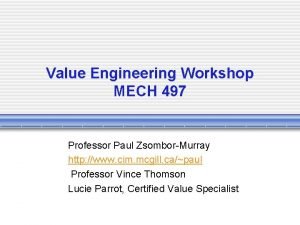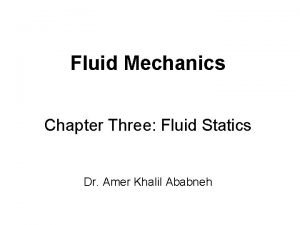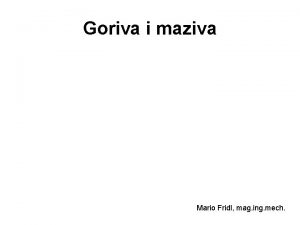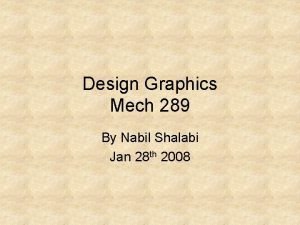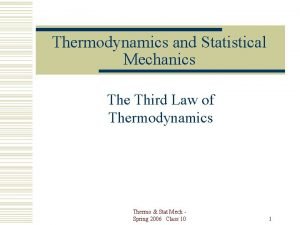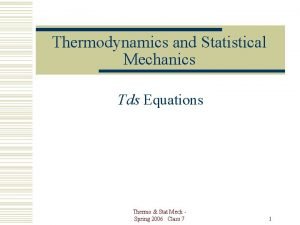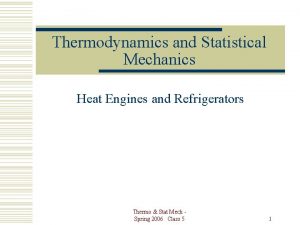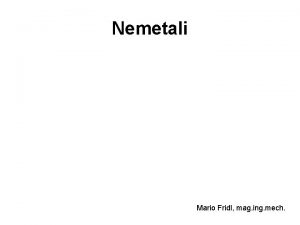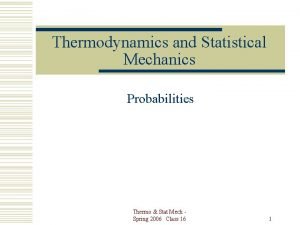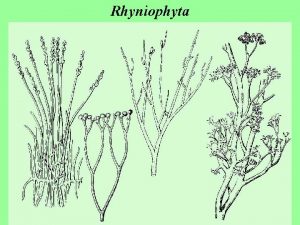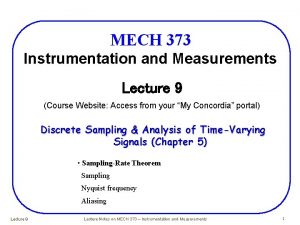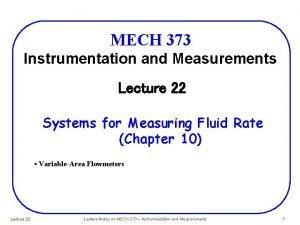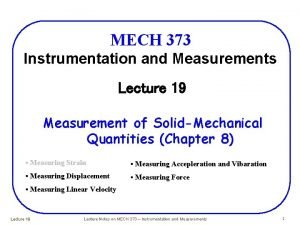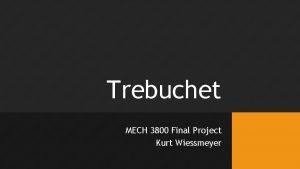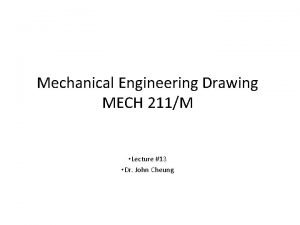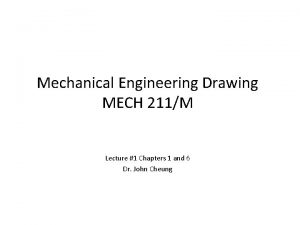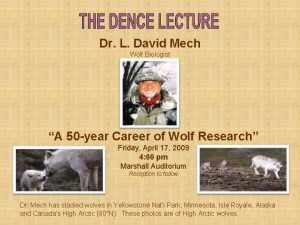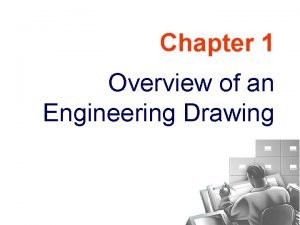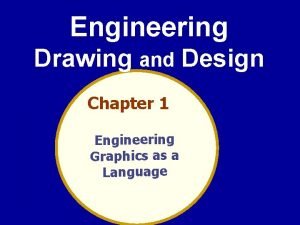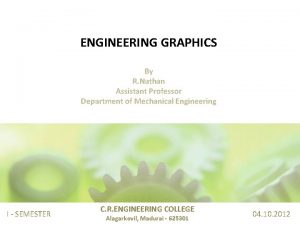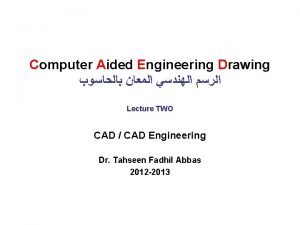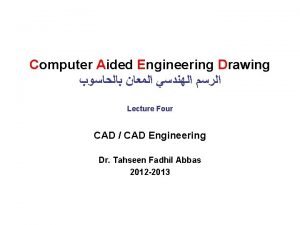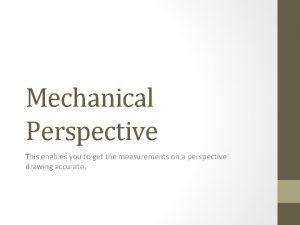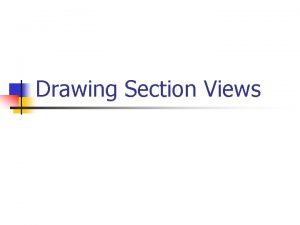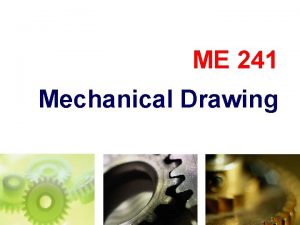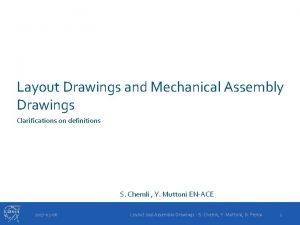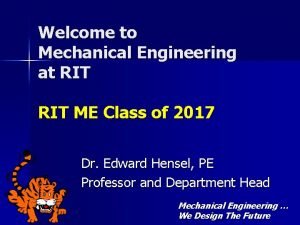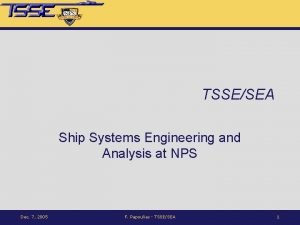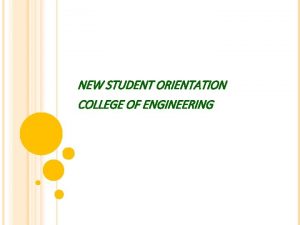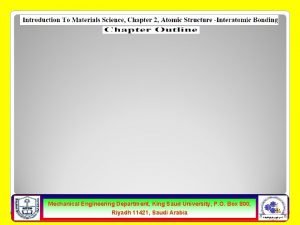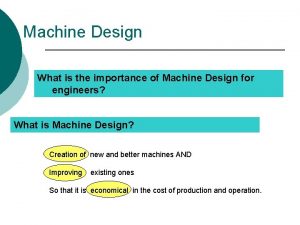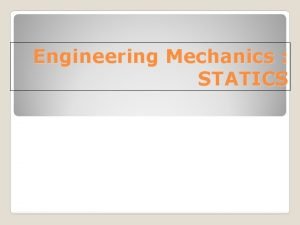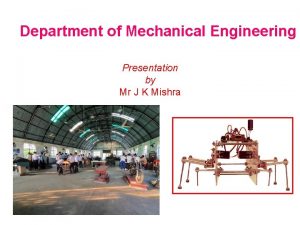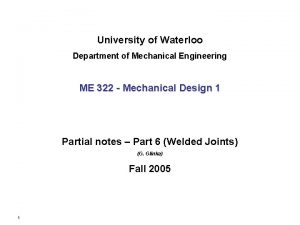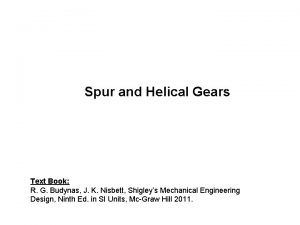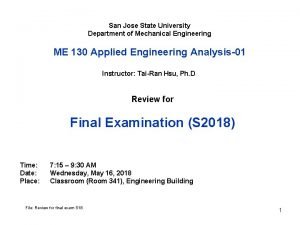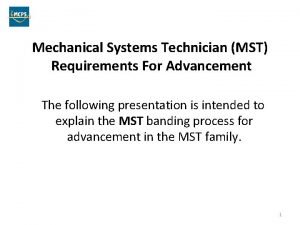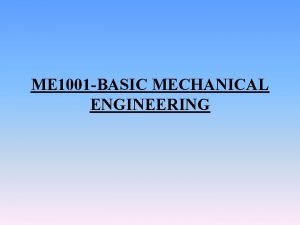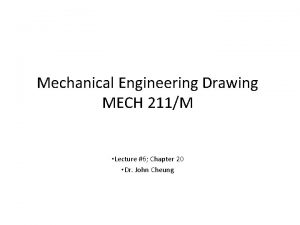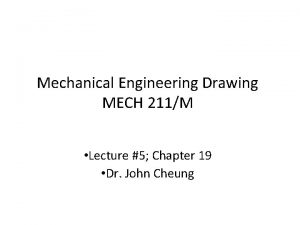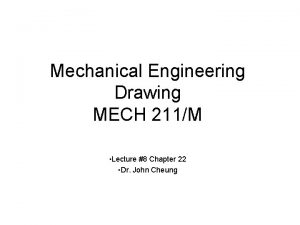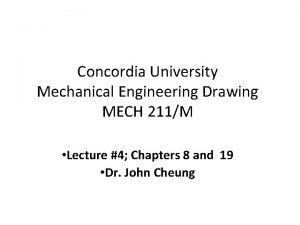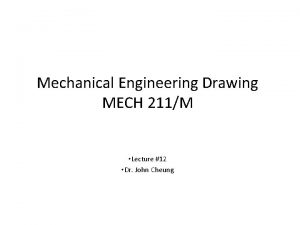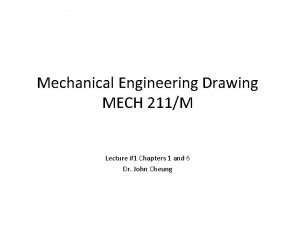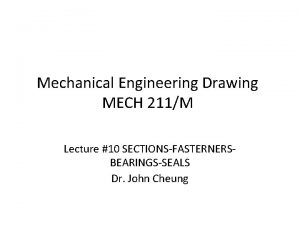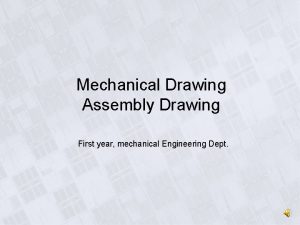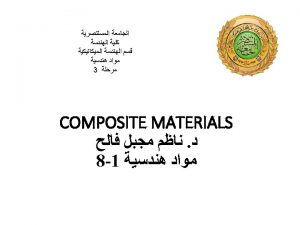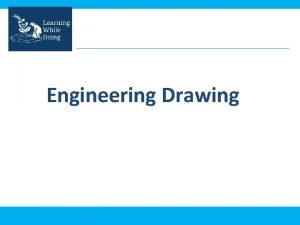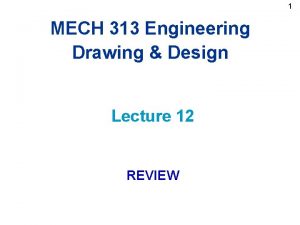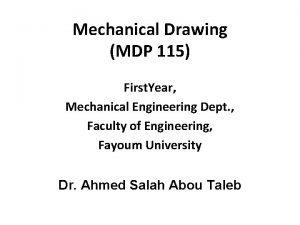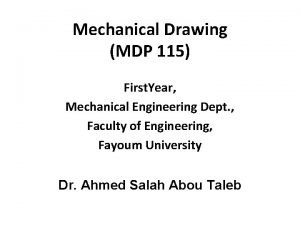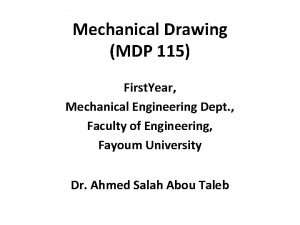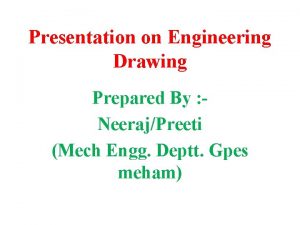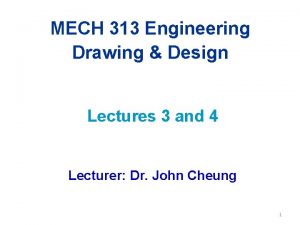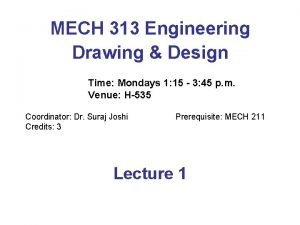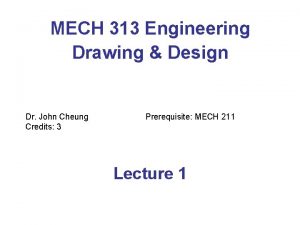Mechanical Engineering Drawing MECH 211M Lecture 7 Chapter




















































- Slides: 52

Mechanical Engineering Drawing MECH 211/M • Lecture #7, Chapter 11 • Dr. John Cheung

Intersections of Plane and Vertical Prism – Edge view method 2

Intersection of Plane and Oblique Prism 3

Intersection of Plane and Oblique Prism • Use Prism edge as EV. • Cut Line 1 -2 at Point 4 and Line 2 -3 at 5. • Front view – Line 4 -5 intersects the EV at Point A. • Project Point A to Top view. 4

Intersection of Plane and Oblique Prism 1. Use parallelism theorem. 2. Use other prism edges as the cutting plane. 3. Repeat the procedure. 5

Intersection of Plane and Oblique Prism 6

Intersection of Plane and Pyramid 7

Intersection of Plane and Pyramid 1. Use pyramid edge W-Y as the cutting plane (EV). 2. Intersect Plane line 2 -3 at Point 5 and Line 1 -4 at Point 6. 3. Front view – Line 5 -6 intersects EV –WY at Point A. 4. Project Point A to Top View. 5. Other pyramid edges do not intersect with finite plane. W Y 8

Intersection of Plane and Pyramid 1. Use Plane edge 1 -4 as EV, cutting pyramid edges WX and WY at Points 6 and 11 in Front view. 2. Project Points 6 and 11 to Top view. 3. Line 5 -6 intersects Plane Edge 1 -4 at Point E. 4. Repeat for pyramid edges WX and WZ. 5. Repeat for Plane edge 2 -3. 11 11 9

Intersection of Plane and Pyramid 10

Intersection of Plane and Rightcircular Cylinder – FIG. 21 -5 11

Intersection of Plane and Inclined Cylinder - FIG 21 -6 1. Divide circular section into a number of equal segments (30 degrees) 2. Draw auxiliary view - EV for Plane ABC. 12

Intersection of Plane and Inclined Cylinder – FIG 21 -6 1. Plane EV intersects segments 6 and 10 in auxiliary view. 2. Project intersection point to segments 6 and 10 in Front view leading to 6’ and 10’. 3. Project 6’ and 10’ to Top view. 10’ 6’ 4. Use D 1 to check accuracy 13

Intersection of Plane and Inclined Cylinder – FIG. 21 -6 14

Intersection of Plane and Oblique Cylinder – FIG. 21 -7 1. Use cutting plane method. 2. Divide the cylinder into a number of equal segments (30°) 3. Use the segment as the cutting plane. 15

Intersection of Plane and Oblique Cylinder –FIG. 21 -7 1. Use segment 0 -0’ as cutting plane in Front view 2. Intersect Plane Line AB at d and Line BC at e. 3. Project Point d and e to Top view. 4. Line d-e intersects segment 0 -0’ at Point 0” in TV. 5. Project 0” to FV. 16

Intersection of Plane and Oblique Cylinder – FIG 21 -7 1. Use parallelism method. 2. To construct other intersection points based on Segment Line 0 -0’ slope. 17

Intersection of Plane and Oblique Cone – FIG 21 -8 1. Divide cone base into a number of equal segments. 2. Use Plane ABC EV as Cutting plane. 18

Intersection of Plane and Oblique Cone – FIG 21 -8 1. Plane EV ABC in FV cut segments X-13 and X-5 at Points 13’ (front) and 5’ (back). 2. Project Points 13’ and 5’ to TV. 19

Intersection of Plane and Oblique Cone – FIG 21 -8 20

Oblique Plane and Cone – FIG 21 -9 1. Use parallelism method. 1’ 2’ 2. Cutting plane // to BC in both Front and Top views. 3. Draw EV 1 -2 in FV. 4. Intersect cone side. 5. Draw circle diameter in TV = to intersected cone section. 6. TV – EV 1 -2 intersects the circle of cone at Points 1” and 2” 7. Repeat for other cone sections. 21

Oblique Plane and Cone –FIG. 21 -9 22

Oblique Plane and Cone –FIG 21 -9 USING EV METHOD 23

Intersection of Two Solids – FIG 21 -10 Using solid edges as the cutting plane. 24

Intersection of Solids – FIG. 21 -10 1. Use edges 1 -1’ and 4 -4’ of the inclined prism as the cutting plane in TV. 2. EV 1 -1’ intersects vertical prism edge DE at Point 5 and edge BA and Point 9 in TV. 3. Project P 5 and P 9 to FV the edge 1 -1’ of the inclined prism. 4. Repeat for inclined prism edge 4 -4’. – Yield Points 10 and 16. 25

Intersection of Solids – FIG. 21 -10 • Use vertical prism edges as the cutting plane. • Use Edge D (EV) in TV. It intersects Line 1 -2 at P 6’ and Line 3 -4 at P 15’. • Project P 6’ and P 15’ Lines 1 -2 AND 3 -4 in FV. • Use parallelism theorem, draw line from P 6’ and P 15’ // to inclined prism edges. • Line from 6’ intersects Edge D at P 6 and from P 15’ at P 15. • Repeat for edges C and B. 26

Intersection of Solids – Fig. 20 -10 • Figure of intersection: The intersection of two solids. 27

Intersection of a Prism and Cone 28

Intersection of a Prism and Cone 29

Intersection of a Prism and Cone 30

Intersection of Shortened Cone and Prism FIG. 21 -13 1. Use EV parallel to cone base. 2. Cut horizontal circle in cone and straight line of prism. 3. Circle of cone intersects prism edge (vertical) at 2 points of each side in FV. 31

Intersection of Circular Cylinders – FIG. 21 -14 32

Intersection of Circular Cylinders 33

Intersection of Circular Cylinder & Cone Axes Intersecting –FIG. 21 -15 1. Divide horizontal cylinder into a number of segments. 34

Intersection of Circular Cylinder & Cone Axes Intersecting –FIG. 21 -15 1. Locate P 3 in cone at TV. 2. Line 3 intersects Edge D at 3’. 3. Project P 3’ to FV. 35

Intersection of Circular Cylinder & Cone Axes Intersecting –FIG. 21 -15 1. Repeat for segments B, D and F. 36

Intersection of Circular Cylinder & Cone Axes Intersecting –FIG. 21 -15 37

Intersection of Circular Cylinder & Cone Axes Non-intersecting 38

Intersections of Circular Cylinders and Cones (Sphere Method) 39

Intersections of Circular Cylinders and Cones (Sphere Method) FIG. 21 -17 40

Intersections of Circular Cylinders and Cones (Sphere Method) FIG. 21 -17 1. Sphere B cuts two vertical circles in cylinder at C-C and B-B. 2. Sphere B Cut one horizontal circle in cone at A-A. 3. 3, EV A-A intersects EV CC at P 2. 41

Intersections of Circular Cylinders and Cones (Sphere Method) FIG. 21 -17 42

Intersection of Oblique Cone & Cylinder (Constructing the Top View) 43

Intersection of Oblique Cone & Cylinder (Plane Cutting Elements) – FIG 21. 19 a 1. Determination of limiting plane in cone and cylinder. 2. Pass the vertex. 3. Cut or be tangent to the base. 4. Line V-P passes through vertex and intersects the extended cone base plane at Point P. 5. Line P-1 tangent to circular base at Point 1. Line of tangency –V-1. 6. Plane V-P-14 cuts the cone at P 6 and P 14. 7. Cutting elements – V-6 and V 14. 44

Intersection of Oblique Cone & Cylinder (Plane Cutting Elements) – FIG 21. 19 b 1. Cutting plane parallel to elements of axis. 2. Cut or be tangent to the base. 3. Line V-P in TV parallel to cylinder (any plane with VP line // to the cylinder). 4. Draw lines in TV tangent to and secant to the lower base P-14 and P 12. 5. Element of tangency 13 -13’. 6. Cutting elements 12 -12’ and 14 -14’. 45

Intersection of Oblique Cone & Cylinder FIG. 21 -20 1. Cone – Limiting plane – V-P-9. 2. Cylinder – Limiting plane – V-P-13 (P 13 Tangent point. ) 46

Intersection of Oblique Cone & Cylinder FIG. 21 -20 1. Number of system – important. 2. Starting from the limiting plane. 3. Number consecutively -anticlockwise – must not continue beyond a secant limiting plane. 4. When secant limiting plane reached, direction reversed, placing only one number at the secant point. 5. On the other base, No 1 and 2. . Assigned on the same line. 47

Intersection of Oblique Cone & Cylinder FIG. 21 -20 48

Intersection of Oblique Cone & Cylinder FIG. 21 -20 49

Intersection of Oblique Cones 50

Intersection of Oblique Cylinders 51

Intersection of Cone & Cylinder Bases in Nonparallel Planes 52
 Standard mechanical engineering drawing scales
Standard mechanical engineering drawing scales 01:640:244 lecture notes - lecture 15: plat, idah, farad
01:640:244 lecture notes - lecture 15: plat, idah, farad Isometric drawing 30 60
Isometric drawing 30 60 Mech 497
Mech 497 Mech in ns
Mech in ns Integral of force
Integral of force Mag ing mech
Mag ing mech Mech 289
Mech 289 Stat mech
Stat mech Tds equation in thermodynamics
Tds equation in thermodynamics Stat mech
Stat mech Mag ing mech
Mag ing mech Thermodynamic probability ppt
Thermodynamic probability ppt Nauka o mechorostech
Nauka o mechorostech Mech robotix
Mech robotix Mech
Mech Mech
Mech Mech
Mech Trebuchet mech
Trebuchet mech Backstop mechanical engineering
Backstop mechanical engineering Mech 211
Mech 211 Dr david mech
Dr david mech Actual mechanical advantage vs ideal mechanical advantage
Actual mechanical advantage vs ideal mechanical advantage Engineering drawing chapter 1
Engineering drawing chapter 1 Triangles in technical drawing
Triangles in technical drawing Drawing lecture
Drawing lecture Drawing lecture
Drawing lecture Drawing lecture
Drawing lecture Financial engineering notes
Financial engineering notes Software engineering lecture notes
Software engineering lecture notes Foundation engineering lecture notes
Foundation engineering lecture notes Engineering ethics lecture notes
Engineering ethics lecture notes A perspective drawing which is mechanically done
A perspective drawing which is mechanically done Types of lines in engineering drawing
Types of lines in engineering drawing Engineering drawing section view
Engineering drawing section view General assembly drawing example
General assembly drawing example Layout assembly drawing
Layout assembly drawing Ytu erasmus ofisi
Ytu erasmus ofisi Steven day rit
Steven day rit Nps mechanical engineering
Nps mechanical engineering Adfing
Adfing Cpp mechanical engineering roadmap
Cpp mechanical engineering roadmap King saud university mechanical engineering
King saud university mechanical engineering Need of machine design
Need of machine design Statics center
Statics center Mechanical engineering presentation
Mechanical engineering presentation Adelien heutink
Adelien heutink Butt weld
Butt weld Mecop oregon state
Mecop oregon state Mechanical engineering design book
Mechanical engineering design book Sjsu mechanical engineering
Sjsu mechanical engineering Mst mechanical engineering
Mst mechanical engineering Basic mechanical engineering syllabus
Basic mechanical engineering syllabus



